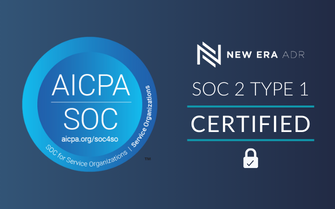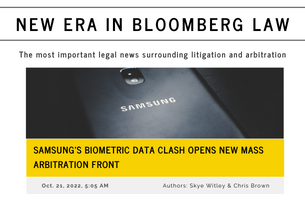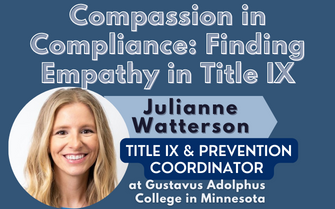
If you’re a Title IX Coordinator, you know two things for sure:
- You are the point-person for federal compliance.
- And, that compliance is always changing.
When interviewing for my Title IX Coordinator role I was told over and over again that the position came with “high institutional risk.” But what does that “risk” mean exactly? Well… If a Coordinator acts with “deliberate indifference,” – they forget to follow up on a sexual misconduct report, issue unfair supportive measures, or penalize a responding party before they’re found responsible- the school can easily face a massive lawsuit.
The interviewers weren’t trying to scare me. They were telling me something that becomes truer every day. Mistakes in Title IX can crumble an institution. They can bankrupt it, forever tarnish its reputation, and diminish trust from recruits, alums, and current students and staff. They can destroy all faith in the school. You may be thinking of major Title IX lawsuits and the demise that followed. There are many.
But interestingly enough, the heart of the law hasn’t actually changed since 1972:
“No person in the United States shall, on the basis of sex, be excluded from participation in, be denied the benefits of, or be subjected to discrimination under any education program or activity receiving Federal financial assistance…”
It’s a tiny paragraph that sounds simple enough. But it’s more complicated than ever. And it’s only in the last decade that colleges and universities saw specific federal guidance in how to “do” Title IX. Yes, our institutions should be free from sex discrimination, but:
- What IS sex discrimination?
- How do we measure it?
- And how do schools make decisions that are fair, impartial, and effective?
These answers continue to evolve with every US administration change. In order to anticipate Title IX’s immediate future, it’s important to understand its history. So…How did we get here?
1972: Title IX and Women in Athletics
When we first thought of Title IX, we thought of women’s access to sports. Pre-Title IX, women didn’t enjoy many opportunities in athletics. The NCAA gave no scholarships to women, hosted zero women’s championships, and lacked overall supplies and funding for female athletic teams. Merely 30,000 women participated in NCAA as opposed to 170,000 men.
Title IX corrected that mismatch, and female athletic involvement soared to more than 150,000 athletes. Title IX also lessened high school girls’ dropout rate and increased the number of women pursuing higher education. Overall, it arguably advanced the collegiate careers of female athletes.
But we still weren’t talking about sexual misconduct in colleges and universities. Sexual assault, harassment, and stalking no doubt happened on college campuses but were seldom reported. Without overall awareness, a reporting process in place, or access to resources and support, victims’ only option was to stay silent or report to police. In the next four decades, sexual assault awareness increased, but there remained little to no guidance on how schools should address sexual misconduct claims.
Obama’s 2011 Dear Colleague Letter drastically changed that.
2011: Title IX and the Dear Colleague Letter
The Dear Colleague letter fundamentally altered Title IX compliance for colleges and universities. For the first time ever, the government provided guidance in HOW to process sexual misconduct claims. More importantly, if schools failed to take action, they risked federal investigation per the Office of Civil Rights (OCR). A decade of grueling Title IX analysis and scrutiny followed.
Some of these hallmark changes included using the “preponderance of evidence” or “more likely than not,” decision making standard, making a responsible finding way more likely than the “clear and convincing” standard. Parties also must have an option to appeal an outcome, and cases should be completed in a 60-day “prompt timeframe.”
Involved parties’ rights and resources were heavily enforced, and everyone needed to be aware of a Title IX policy, grievance process, and case outcomes. It also wasn’t enough to simply respond to reports. Prevention and education requirements like consent programming, bystander intervention training, and reporting guidance had to be made clear and available to the college community. For most schools this meant that someone was now responsible for this work. It was no longer acceptable to operate without a Title IX policy, victim resources, or a timely process. Up until now, cases were possibly handled through regular conduct, or worse, completely ignored.
Betsy DeVos, former Secretary of Education under President Trump, made sweeping changes to these rules in 2020.
2020: Trump’s Unprecedented Title IX
The Trump Administration promptly rescinded the Dear Colleague Letter in 2017 and issued new regulations in 2020. These were considered the first complete rule-making on Title IX and the only one dedicated to sexual harassment.
Regulations drastically narrowed the definition of Title IX and sexual harassment. As a result, schools could respond to fewer reports of sexual misconduct–specifically off-campus incidents not considered in a college’s “program.” Alleged incidents had to be considered “severe, pervasive, and (instead of ‘or’ ) objectively offensive” to meet the threshold of sexual harassment.
The live hearing with cross examination requirement proved to be the most contested during the comment period. Supporters of Title IX hearings said that respondents should have the right to ask questions about serious allegations like assault and harassment. Opponents expressed concern that hearings would re-traumatize complainants and squash reporting.
The massively increased need for legal, administrative, and financial support became clear under this ruling. Institutions now needed to provide college-appointed advisors, a live hearing panel, and investigators, all separate from the Title IX Coordinator.
Under these rulings, Title IX processes became longer, more consuming, and more focused on equal rights for all parties involved.
2021: Biden’s Proposed Title IX Changes
In March 2021, President Biden issued an executive order to review the 2020 regulations. A month later, OCR announced that a new rule-making proposal would follow.
Many Title IX administrators hoped these regulations would reflect the Obama era with no required live hearings, elimination of the lengthy “directly related evidence” phase, and a shorter resolution timeframe–in short, more victim access and support and a less invasive grievance process.
The proposed rule-making is currently in a comment period expected to end this month.
Significant highlights include:
- Live hearings are no longer required. But schools will need to “assess credibility” of parties in a virtual or in-person manner. Schools might decide that live hearings are more efficient in this case.
- Widened scope to include all forms of sex discrimination, not just sexual harassment.
- Stricter requirements on allegations schools must investigate.
- Emphasis on protecting pregnant people and requirements to provide modifications, break times, and lactation spaces for students and staff.
- Include protection against discrimination on sexual orientation and gender identity.
- A forthcoming notice proposing rule-making for athletics participation.
Related Article: Proposed Title IX Changes from the Biden Administration and the Department of Education
What’s next?
As Title IX Coordinators wait for finalized regulations, we can anticipate another policy overhaul, increased need for legal expertise, and a widened scope of responsibilities. We can also assume that our Title IX team (including Deputy Coordinators, decision makers, and investigators) must be even more careful in remaining fair and unbiased.
We need to be thinking about how we adopt our policies to further protect members of the LGBTQIA+ communities, as well as pregnant students and staff. What can we do to make our facilities more inclusive and accessible? How do we allocate our financial, administrative, and personnel resources to make these changes? Title IX federal compliance will (again) become critical to institutional integrity. Without it, the risk is immeasurable.
For now…we wait for finalized rulings.

Julianne Watterson is a Title IX and Prevention Coordinator at Gustavus Adolphus College in Minnesota. In her free time she loves copy and content writing, fostering rescue dogs, and visiting as many national parks as possible.




